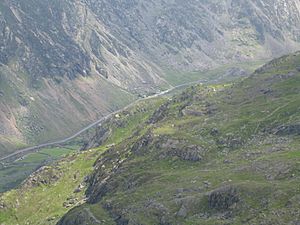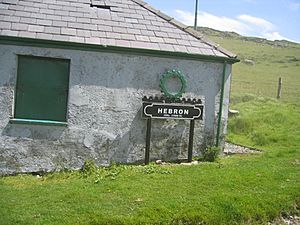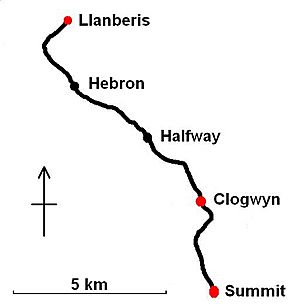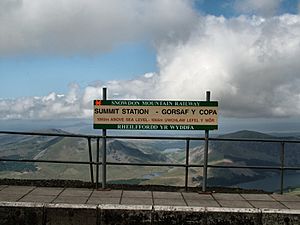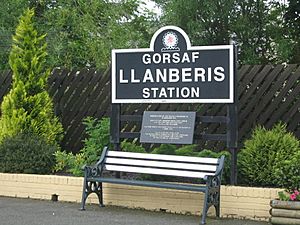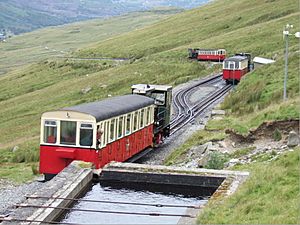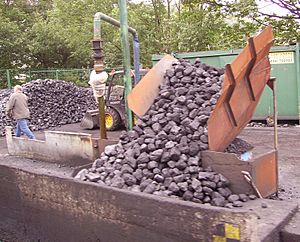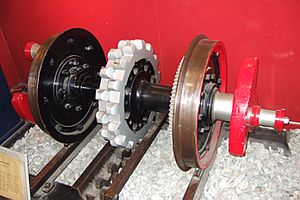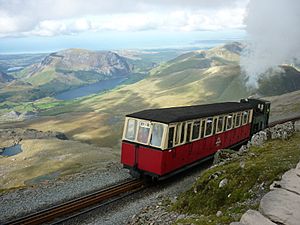Snowdon Mountain Railway facts for kids
Quick facts for kids Snowdon Mountain RailwayRheilffordd yr Wyddfa |
|
|---|---|
 |
|
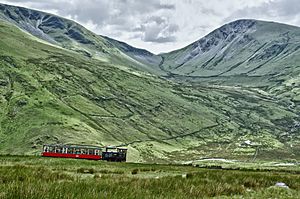
Snowdon Mountain Railway in June 2012
|
|
| Overview | |
| Owner | Heritage Great Britain |
| Locale | Gwynedd |
| Termini | Llanberis Snowdon/Yr Wyddfa |
| Service | |
| Type | Rack-and-pinion mountain railway |
| Operator(s) | Heritage Great Britain |
| History | |
| Opened | 6 April 1896 |
| Technical | |
| Line length | 4 mi 55 ch (7.5 km) |
| Number of tracks | Single track with passing loops |
| Rack system | Abt |
| Track gauge | 800 mm (2 ft 7 1⁄2 in) |
The Snowdon Mountain Railway (SMR; Welsh: Rheilffordd yr Wyddfa) is a special narrow gauge rack-and-pinion mountain railway in Gwynedd, north-west Wales. It's a fun tourist railway that travels about 4.7 miles (7.6 km) from Llanberis to the top of Snowdon. Snowdon is the highest mountain in Wales!
The SMR is the only public rack-and-pinion railway in the United Kingdom. It has been running for over 100 years and is still very popular. More than 140,000 people ride it every year. Heritage Great Britain, a company that runs other tourist spots, owns and operates the railway.
The railway operates in some of Britain's toughest weather. Sometimes, trains can't reach the very top in bad weather. It also closes during winter, from November to mid-March. Single trains are pushed up the mountain by either steam locomotives or diesel locomotives.
The railway's traditional logo shows a gear wheel (pinion) connected to a toothed bar (rack). This shows the special rack railway technology it uses.
Contents
History of the Railway
Building the Line
The idea of a railway to Snowdon's summit came up in 1869. This was when Llanberis got a railway link to Caernarfon. In 1871, a plan was made to build the railway. But a local landowner, Assheton-Smith, didn't like the idea. He thought a railway would ruin the beautiful scenery.
For 20 years, nothing happened because Assheton-Smith still said no. But in 1893, a nearby train station was renamed "Snowdon." This made many tourists go there instead of Llanberis. This started to affect the businesses in Llanberis.
After a lot of talking, Assheton-Smith finally agreed to the railway. The line was built on private land bought by the company. This meant they didn't need a special law from Parliament.
Building the railway started in December 1894. Enid Assheton-Smith, a local girl, cut the first sod (a piece of ground). Locomotive No. 2 was later named after her. The railway was finished in February 1896. It cost about £63,800, which was a lot of money back then. Sir Douglas Fox and Andrew Fox were the engineers.
By April 1895, half of the earthworks were done. This shows how hard the workers pushed to build it.
All the tracks had to be laid starting from one end. This was to make sure the rack rail was perfectly straight. The first locomotives arrived in July 1895. But not much track was laid until August. That's when two big bridges near Llanberis were finished. Then, progress up the mountain was fast. The locomotives helped move building materials. Even with harsh weather, the first train reached the summit in January 1896. The railway was planned to open at Easter.
Before opening, an official from the Board of Trade checked the line. He was happy with it. He suggested that wind speed should be checked. If the wind was too strong, trains should stop.
On April 4, a test train hit a rock that had fallen onto the track. Some wheels came off the rails. Workers on the train managed to put them back on. The train then continued its journey.
Opening Day Accident
The railway officially opened on Monday, April 6, 1896. Two trains went up to the summit. On the first trip back down, something went wrong. Locomotive No. 1, named Ladas, with two carriages, came off the rack rail. This meant it lost its brakes and sped out of control. The locomotive went off the track and fell down the mountain. A passenger who jumped from the train was badly hurt and sadly passed away.
After this, the second train coming down hit the carriages of the first train. Luckily, no one else was hurt in this second crash.
An investigation found that the ground had settled after building. This, combined with the train going too fast because it was too heavy, caused the accident. Because of this, the railway changed its rules. Trains could only carry less weight. Also, a special gripper system was added to the rack railway for extra safety.
Early Years
The railway reopened to Hebron station in September 1896. By June 1897, trains were reaching the summit again. This time, there were no problems, and the train service continued.
In 1910, there were reports of people causing trouble on the line. One man was hurt when he slid down the track on a stone. The railway manager also said that visitors were breaking fences and messing with the track.
By 1936, the railway was carrying 30,000 people to the summit each season.
Trains still ran during the Second World War. But the summit was closed for military use from 1942 until the war ended.
After the War
Normal train service started again in 1946. There was a shortage of coal, so the railway even tried burning old army boots as fuel!
In 1983, the buildings at the summit were given to the local council. In 1985, the railway raised money to buy its first diesel locomotives.
100th Birthday
For its 100th birthday in 1996, the railway held a special weekend. People could visit the railway's workshops, which was a rare chance.
New Summit Building
In 2006, the old cafe at the Snowdon summit was taken down. Work began on a new visitor centre. While this was happening, passenger trains stopped at Clogwyn station. But a works train still carried workers and materials to the building site. The new building, Hafod Eryri (which means "high summer residence of Snowdonia"), opened in June 2009.
Mountain Rescues
In 2015, the railway helped in a mountain rescue. A rescue helicopter couldn't reach the summit. So, the railway carried mountain rescue teams up Snowdon. They rescued a 17-year-old girl who had collapsed. The train then brought her and the rescuers back down the mountain.
The Railway Route
The journey starts at Llanberis station. This is right next to the main road. The railway has a single track with places where trains can pass each other. It is about 4 miles 1,188 yards (7.524 km) long. The track goes uphill quite steeply, with an average slope of 1 in 7.86. The steepest parts are 1 in 5.5.
The railway climbs a total of 3,140 feet (957 m). It starts at 353 feet (108 m) above sea level in Llanberis. It ends at Summit station, which is 3,493 feet (1,065 m) high. The actual summit of Snowdon is only 68 feet (21 metres) higher.
Some of the stations along the way include:
- Waterfall: This station is now closed, but the building is still there. It was built for visitors to see a waterfall.
- Hebron: Named after a nearby chapel.
- Halfway: As the name suggests, it's about halfway along the line. There's a path from here to a cafe.
- Clogwyn: This station is on an open ridge. It looks out over the Llanberis Pass.
How the Railway Works
The main railway offices, engine shed, and workshop are all at Llanberis.
Controlling the Trains
Train movements are controlled from Llanberis. People at Llanberis, Clogwyn, and the Summit talk to each other using two-way radio.
The line has three places where trains can pass each other. These are at Hebron, Halfway, and Clogwyn stations. It takes about 15 minutes to travel between them.
Trains usually take one hour to go up to the summit. They take another hour to come back down. The average speed is about 5 mph (8 km/h).
Trains normally go all the way to the Summit. But if the wind is too strong at Clogwyn Station, trains might stop at Rocky Valley Halt for safety.
Sometimes, two trains can run close together. This is called a "doubler." All the platforms and passing loops are long enough for two trains.
At Llanberis, there are two platforms. One is for trains arriving, and the other is for trains leaving. At the Summit, trains usually switch between the two platforms.
When both steam and diesel trains run, the diesel train usually goes up first. This gives the steam train more time to get ready.
Locomotives stay with the same carriage all day. Any locomotive can work with any carriage.
In 2013, four new carriages were introduced. They can carry 74 passengers, which is more than the old ones (56 passengers). These new carriages work with the four diesel locomotives.
Steam vs. Diesel Trains
For steam trains, the engine needs to go to a water crane and coal area at Llanberis. Steam locomotives also get water at Halfway Station.
Diesel locomotives are used for regular trains. Steam locomotives are used for special "Heritage Steam" trains, which cost more. Diesel trains can turn around quickly. Steam trains take longer to get ready, so they can't run as often.
Using diesel locomotives saves money on fuel and running costs. This has allowed the railway to stay open for more of the year.
The railway management says that most passengers don't mind if the train is steam or diesel. In the late 1980s, it was clear that diesels made more economic sense.
| From 1987 | Steam | Diesel |
|---|---|---|
| Round trip fuel costs | £51.00 (about £103.38 today) | £3.05 (about £6.18 today) |
Railway Technology
Rack Rail System
The railway uses an 800 mm gauge track. This is similar to some railways in Switzerland. The rails are attached to steel sleepers. The line uses the Abt rack system. This system has a toothed rail (the rack) between the normal rails. A toothed wheel (the pinion) on the train's axle connects with this rack. These pinions help the train move up and down the steep slopes. The train's wheels just support and guide it.
Train Setup
For safety, trains have one locomotive pushing a single carriage up the mountain. The locomotive then leads the carriage down, using its brakes for a controlled descent. The carriage is not connected to the locomotive. Gravity keeps them together.
Trains and Carriages
The railway has owned eight steam locomotives, five diesel locomotives, and three diesel railcars over the years.
Locomotive History
When the railway was planned, Switzerland had the most experience with rack locomotives. So, Swiss companies built the first engines for the Snowdon Mountain Railway. The boilers on the locomotives are tilted. This keeps the water level correct when the train goes up the mountain.
The first five locomotives (Nos. 1 to 5) were built in 1895 and 1896. They cost about £1,525 each. Locomotives 1 to 3 arrived before the line opened and helped with construction.
For most of its history, the railway's steam locomotives burned coal. Sometimes, it was hard to get the right kind of coal. In 2000, No. 2 was even fitted to burn oil to help with this problem.
Three more steam locomotives (Nos. 6 to 8) arrived in 1922–23. They were similar in size and power but had a different design.
The railway first thought about using a diesel locomotive in the early 1970s. But it wasn't until the mid-1980s that they bought diesel locomotives that could pull trains up the line. Between 1986 and 1992, four diesel locomotives (Nos. 9 to 12) were bought.
In 1995, three diesel railcars (Nos. 21 to 23) were delivered. These could run as two- or three-car trains. However, they had problems and were taken out of service by 2003. They were later scrapped.
In 2019, the railway ordered two new hybrid locomotives. These were designed to use both diesel and battery power. The idea was to save fuel and be quieter. But in 2022, they were returned because they didn't generate enough energy when going downhill.
Passenger Carriages
All the old passenger carriages were taken out of service at the end of 2012. The railway now has two types of services:
- Traditional Diesel Service: Four brand new coaches were built for the 2013 season. These are used only with the diesel locomotives. They can carry 74 passengers. These coaches are named after famous Welsh people like Sir David Brailsford CBE and Dame Shirley Bassey.
- Heritage Steam Experience: A new body was built on the original frame of an old coach (Coach 2). It looks like an original coach from 1895. This coach, named Snowdon Lily, started service in 2013. It carries only 34 passengers and costs more to ride. Because it was so popular, a second heritage coach, the Snowdon Mountain Goat, was built in 2015.
Train Colours
In old photos, the steam locomotives looked black. Red lines were added in 1933. Later, they were painted green. From 1995 to 2000, they were painted different colours. Since 2000, they have mostly been green.
The original carriages were open and probably dark brown. They were painted red, grey, green, and orange in the 1930s. After World War II, the carriages were enclosed. They were first brown, then changed to crimson and cream in 1960.
The diesel trains were green until 1998. Then they were painted different colours, like red or purple. Since 2004, they have mostly been green again. From 2013, they were painted black.
Opening Day Accident Details
The First Train's Journey
The railway opened to the public on Monday, April 6, 1896. A train went up first to check the line. Then, locomotive No. 1 Ladas left Llanberis with two carriages, carrying the first official passengers. Another train, No. 2 Enid, followed shortly after. The climb up was fine, but the top of the mountain was covered in mist.
Around noon, Ladas started its journey back down. About one-half mile (0.8 km) above Clogwyn station, the locomotive came off the rack rail. This meant it lost its braking power and started speeding down the track. The driver and fireman realized the train was out of control and jumped off.
Ladas continued for about 110 yards (100 m) before going off the track on a curve and falling down the mountain. The two carriages sped up, but their automatic brakes kicked in. These brakes stopped the carriages safely. However, one passenger, Ellis Griffith Roberts, jumped from the carriage when he saw the crew jump. He was severely injured and later died.
The Second Train's Journey
When locomotive No. 1 derailed, it broke the telegraph lines used for signaling. Because of this, the people at the summit either got a wrong signal or thought the system had failed. So, the second train left the summit to go down.
Even though the line speed was only 5 mph (8 km/h), and someone was sent to warn the second train, it didn't stop in time. It reached the spot where No. 1 had come off the rack. The same thing happened: No. 2 lost the rack rail and sped out of control. But this time, the carriages from the first train were blocking the line. No. 2 hit them hard. This made the first train's carriages slide down the line, and No. 2 dropped back onto the rack rail and stopped safely. The carriages from the first train rolled down to Clogwyn station and came off the tracks there.
Locomotive No. 1 was later recovered and taken back to Llanberis.
The Investigation
The investigation found that the ground had settled due to freezing and thawing weather. This caused the tracks to twist, reducing the connection between the rack and the train's pinion. The train's weight and speed made the problem worse. The damage from the first derailment made the second one almost certain.
Safety Changes
The first change was to reduce the maximum weight trains could carry. This meant a smaller, lighter carriage was bought. From then on, only this lighter carriage was used with one of the original ones for two-carriage trains.
The second change was to add a special gripper system. This involved adding extra rails to the rack and a special part to the locomotives and carriages for extra grip.
See also
- Llanberis Lake Railway
- British narrow gauge railways
- Snowdonia National Park
- List of wind-related railway accidents



